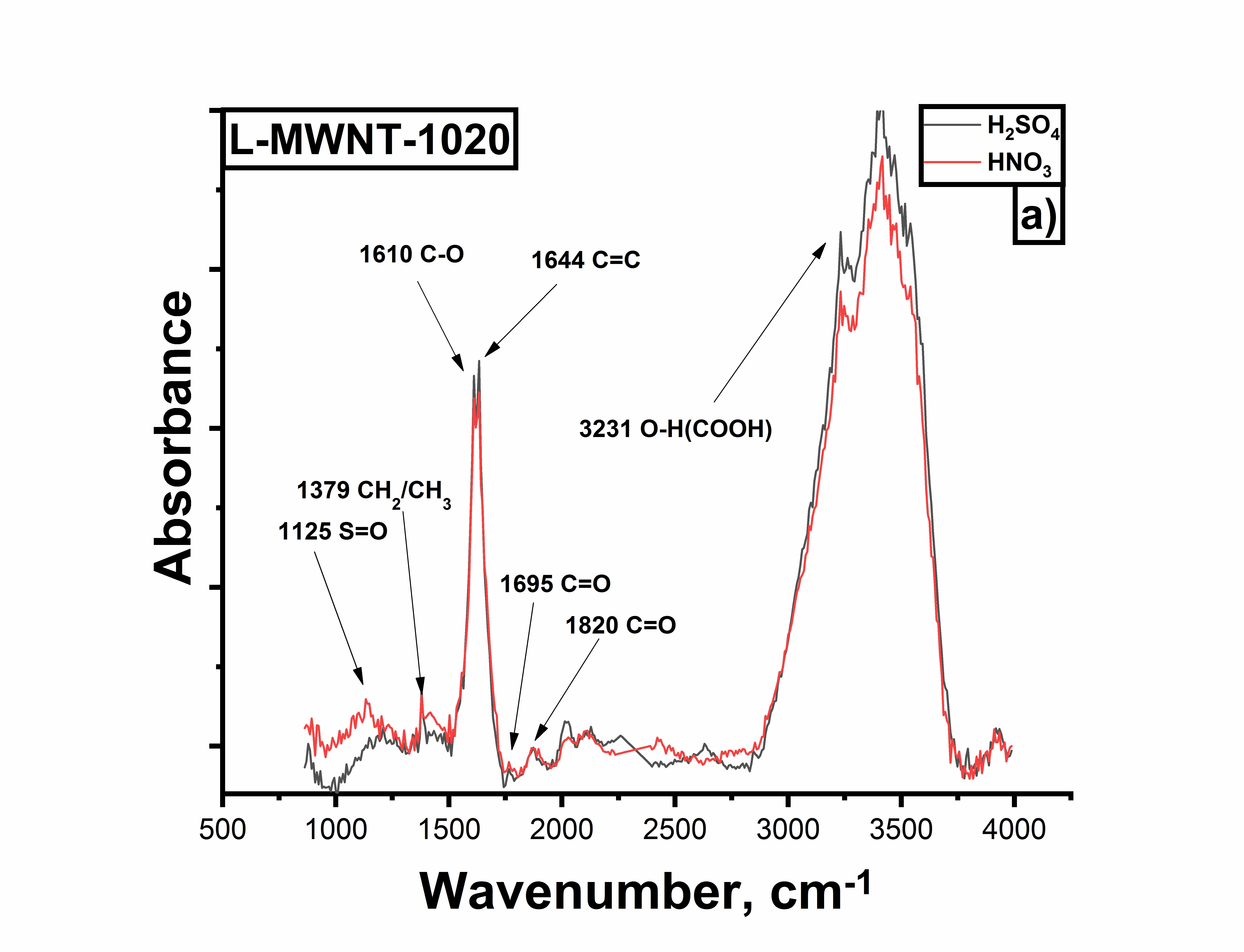
Effect of chemical treatment of multi-walled carbon nanotubes on the specific capacitance of supercapacitors
Abstract
Keywords
Full Text:
PDFReferences
Kuvshinov DG, Kurmashov PB, Bannov AG, Popov MV, Kuvshinov GG. Synthesis of Ni-based catalysts by hexamethylenetetramine-nitrates solution combustion method for co-production of hydrogen and nanofibrous carbon from methane. Int J Hydrogen Energy. 2019;44(31):16271–16286. doi:10.1016/j.ijhydene.2019.04.179
Lee DY, Choi JH, Shin JC, Jung MK, Song SK, Suh JK, et al. Plasma functionalization of powdery nanomaterials using porous filter electrode and sample circulation. Appl Surf Sci. 2018;443:628–34. doi:10.1016/j.apsusc.2018.02.194
Abdallah NA, Alahmadi YM, Bafail R, Omar MA. Multi-walled carbon nanotubes/polyaniline covalently attached 18-crown-6-ether as a polymeric material for the potentiometric determination of delafloxacin. J Appl Electrochem. 2022;52:311–323. doi:10.1007/s10800-021-01636-z
Cogal S, Celik Cogal G, Oksuz AU. Plasma-modified multiwalled carbon nanotubes with polyaniline for glucose biosensor applications. Int J Polym Mater Polym Biomater. 2018;67:454–461. doi:10.1080/00914037.2017.1342252
Fang Y, Liang Q, Li Y, Luo H. Surface oxygen vacancies and carbon dopant co-decorated magnetic ZnFe2O4 as photo-Fenton catalyst towards efficient degradation of tetracycline hydrochloride. Chemosphere. 2022;302:134832. doi:10.1016/j.chemosphere.2022.134832
Kankala RK, Han Y-H, Xia H-Y, Wang S-B, Chen A-Z. Nanoarchitectured prototypes of mesoporous silica nanoparticles for innovative biomedical applications. J Nanobiotechnol. 2022;20:126. doi:10.1186/s12951-022-01315-x
Falahati M, Sharifi M, Hagen TLMT. Explaining chemical clues of metal organic framework-nanozyme nano-/micro-motors in targeted treatment of cancers: benchmarks and challenges. J Nanobiotechnol. 2022;20:153. doi:10.1186/s12951-022-01375-z
Yu F, Ciou J-H, Chen S, Poh WC, Chen J, Chen J, et al. Ionic covalent organic framework based electrolyte for fast-response ultra-low voltage electrochemical actuators. Nat Commun. 2022;13:390. doi:10.1038/s41467-022-28023-2
Deokar G, Jin J, Schwingenschlögl U, Costa PMFJ. Chemical vapor deposition-grown nitrogen-doped graphene’s synthesis, characterization and applications. Npj 2D Mater Appl. 2022;6:14. doi:10.1038/s41699-022-00287-8
Rajarao R, Kim TH, Bhat BR. Multi-walled carbon nanotube bound nickel Schiff-base complexes as reusable catalysts for oxidation of alcohols. J Coord Chem. 2012;65:2671–2682. doi:10.1080/00958972.2012.699046
Mori H, Ogura Y, Enomoto K, Hara M, Maurstad G, Stokke BT, et al. Dense carbon-nanotube coating scaffolds stimulate osteogenic differentiation of mesenchymal stem cells. PLoS ONE 2020;15:e0225589. doi:10.1371/journal.pone.0225589
Chen C, Ogino A, Wang X, Nagatsu M. Plasma treatment of multiwall carbon nanotubes for dispersion improvement in water. Appl Phys Lett .2010;96:131504. doi:10.1063/1.3377007
Vesali NM, Khodadadi AA, Mortazavi Y, Sahraei AO, Pourfayaz F, Sedghi MS. Functionalization of carbon nanotubes using nitric acid oxidation and DBD plasma. World Acad Sci Eng Technol. 2009;37:177–179.
Hafaiedh I, Euch WE, Clement P, Abdelghani A, Llobet E. Functionalized carbon nanotubes for the discrimination of volatile organic compounds. In: Transducers & Eurosensors XXVII: The 17th International Conference on Solid-State Sensors, Actuators and Microsystems (TRANSDUCERS & EUROSENSORS XXVII), IEEE; 2013, p. 1099–1102. doi:10.1109/Transducers.2013.6626963
Oualit M, Irekti A. Mechanical performance of metakaolin-based geopolymer mortar blended with multi-walled carbon nanotubes. Ceram Int. 2022;48:16188–16195. doi:10.1016/j.ceramint.2022.02.166
Diao G, Li H, Ivanenko I, Dontsova T. Nickel and cobalt effect on properties of MWCNT-based anode for Li-ion batteries. Appl Nanosci. 2020;10:4839–4845. doi:10.1007/s13204-020-01310-4
Liu C, Hayashi K, Toko K. Template-free deposition of polyaniline nanostructures on solid substrates with horizontal orientation. Macromolec. 2011;44:2212–2219. doi:10.1021/ma1023878
de Riccardis MF, Martina V, Carbone D, Rotolo P. Functional characterisations of hybrid nanocomposite films based on polyaniline and carbon nanotubes. Electroactive Polymers: Advances in Materials and Devices. Switzerland: Trans Tech Publications Ltd; 2012, p. 81–86. doi:10.4028/www.scientific.net/ast.79.81
Duc Chinh V, Speranza G, Migliaresi C, Van Chuc N, Minh Tan V, Phuong N-T. Synthesis of Gold Nanoparticles Decorated with Multiwalled Carbon Nanotubes (Au-MWCNTs) via Cysteaminium Chloride Functionalization. Sci Rep. 2019;9:5667. doi:10.1038/s41598-019-42055-7
Liu Z, Tabakman S, Welsher K, Dai H. Carbon nanotubes in biology and medicine: in vitro and in vivo detection, imaging and drug delivery. Nano Res. 2009;2:85–120. doi:10.1007/s12274-009-9009-8
Kirikova MN. Physico-chemical properties of fusionised multi-walled carbon nanotubes [dissertation]. Moscow (Russia): Lomonosov Moscow State University; 2009. p. 25.
Harun MHB, Lamorinière S, Cottam B, Bismarck A, Shaffer M. Removal of oxidative debris from chemically functionalized multi‐walled carbon nanotube (MWCNT). Int J Nanoelectron Mater. 2018;11(1):43–48. doi:10.1039/B611930A
Yan L, Cheng X, Wang Y, Wang Z, Zheng L, Yan Y, et al. Exsolved Co3O4 with tunable oxygen vacancies for electrocatalytic H2O2 production. Mater Today Energy. 2022;24:100931. doi:10.1016/j.mtener.2021.100931
Martínez JSB, González AS, López MC, Ayala FE, Mijangos JC, de Jesús Treviño Reséndez J, et al. Electrochemical degradation of amoxicillin in acidic aqueous medium using TiO2-based electrodes modified by oxides of transition metals. Environ Sci Pollut Res Int. 2022;29:42130–42145. doi:10.1007/s11356-021-15315-1
Wei C, Akinwolemiwa B, Wang Q, Guan L, Xia L, Hu D, et al. Mechano‐fenton–piranha oxidation of carbon nanotubes for energy application. Adv Sustainable Syst. 2019;3:1900065. doi:10.1002/adsu.201900065
Rakow EG. Nanotubes and fullerens. M: Logos; 2006. 376 p.
Brester AE, Golovakhin VV, Novgorodtseva ON, Lapekin NI, Shestakov AA, Ukhina AV, et al. Chemically treated carbon nanofiber materials for supercapacitors. Dokl Chem. 2021;501:264–269. doi:10.1134/s0012500821120016
Vaillant J, Lira-Cantu M, Cuentas-Gallegos K, Casañ-Pastor N, Gómez-Romero P. Chemical synthesis of hybrid materials based on PAni and PEDOT with polyoxometalates for electrochemical supercapacitors. Prog Solid State Chem. 2006;34:147–159. doi:10.1016/j.progsolidstchem.2005.11.015
Khudaish EA, Al-Badri A. A modified Hummers soft oxidative method for functionalization of CNTs: Preparation, characterization and potential application for selective determination of norepinephrine. Synth Met. 2021;277:116803. doi:10.1016/j.synthmet.2021.116803
Shibaev A, Yusin S, Maksimovskii E, Ukhina A, Bannov AG. Chemical treatment of graphite nanoplatelets and their use in supercapacitors. Russ J Appl Chem. 2016;89(5):739–745. doi:10.1134/S1070427216050098
Uvarov NF, Mateyshina YG, Ulihin A, Yusin S, Varentsova V, Varentsov V. Surface electrochemical treatment of carbon materials for supercapacitors. ECS Meet Abstr. 2009;37:2817–2817. doi:10.1149/1.3299286
Sysoev VI, Gusel’nikov AV, Katkov MV, Asanov IP, Bulusheva LG, Okotrub AV. Sensor properties of electron beam irradiated fluorinated graphite. J Nanophotonics 2015;10:012512. doi:10.1117/1.jnp.10.012512
DOI: https://doi.org/10.15826/chimtech.2022.9.3.12
Copyright (c) 2022 Valeriy V. Golovakhin, Ekaterina Yu. Kim, Oksana N. Novgorodtseva, Alexander G. Bannov

This work is licensed under a Creative Commons Attribution 4.0 International License.
Chimica Techno Acta, 2014–2025
eISSN 2411-1414
Copyright Notice







